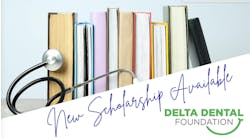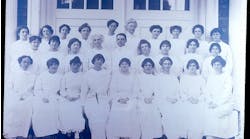Imagine a conversation with four voices from the profession's past
BY ANNE NUGENT GUIGNON, RDH, MPH, CSP
Dinner parties are a wonderful way to spend time with people you like and admire. Time just flies when the conversations are lively. But creating the guest list is when the fun actually starts.
Over the past two years, our profession has lost four incredibly smart and humble visionaries. Each one of them made unique contributions to how we practice dental hygiene today. For the past few months, I've been dreaming about what it would be like to create an imaginary dinner party with these distinguished guests.
• Bill Costerton, PhD - An eminent Canadian microbiologist, known world-wide as the "Father of Biofilms." His pioneering research demonstrated that most microbes thrive and survive in complex polymicrobial communities, and organisms encased in a biofilm behave very differently than their free-floating, planktonic counterparts. It is now acknowledged that caries and periodontal disease are classic biofilm-based infections.
• Tom Holbrook, DDS - A Tampa-based periodontist who for 40 years dared to challenge the status quo about the role of ultrasonic scaling in treating periodontal conditions. Holbrook's relentless quest led him to design unique tip configurations for use in manually tuned magnetostrictive units, ultra-slim designs that just a few years ago became commercially available to clinicians everywhere.
• Michele Darby, RDH, MS - A consummate educator who believed that the dental hygiene education and practice should be supported by a solid body of research, unique to our profession. Among her many visions, she supported student adoption of magnification loupes, realized that power-driven scalers could improve tactile sensitivity, and understood the importance of selecting prophy polish grit based on patient needs, rather than using coarse paste on everyone.
• Irene Woodall, RDH, PhD - A founding editor of RDH Magazine in 1981 and an iconic woman who knew no obstacles. Her relentless passion for dental hygiene positioned our profession to embrace the future as respected, unique health-care providers. Thirty years ago, she championed the adoption of ultrasonic scaling as a basic standard of clinical care, a controversial position at that time.
Have fun eavesdropping on unique dialogue that is taking place at this special event!
Tom: Michele, how nice to see you again. Isn't it great that so many hygienists today are sharing our vision of ultrasonic scaling? Ultrasonic scaling is now being taught in schools all over the country. Imagine more teeth being saved and more clinicians working with less stress to their bodies!1 I think ultrasonics will soon be considered the standard of care.2
Michele: Tom, you are so right. So many hygienists suffer from needless workplace-related musculoskeletal disorders. You expected your hygienists to wear loupes, just as you did. You wanted them to see what you were seeing. And you wanted them to be comfortable.
From my standpoint, the biggest obstacle to using loupes continues to be faculty members who do not want to invest in their own pair.3 They are missing out on being role models. Students look up to their instructors, and we all know how a hygienist practices is a direct reflection of what they learned in school, even if it was years ago. And we learned years ago that power scalers increased tactile sensitivity.4 Just imagine how much more biofilm can be removed with one of your innovative insert designs.
Irene: Back when I first started practicing, we really did not understand what the bacteria were doing. I'm not saying that we now know everything, but, Bill, thanks to your work on biofilms, we now have a deeper appreciation for the complexity of oral disease. You taught us that microbes encased in biofilms act differently than bacteria in a lab culture.5
Tom, your passion for ultrasonics made it possible for hygienists to stand tall when they saw better tissue health after using ultrasonics. In the early days, there was an unwritten code that said "real hygienists hand scale." You helped us break down that notion.1 But the few of us, who truly believed in the power of ultrasonics, continued on despite the fact that there were few scientific studies to support what we were doing.6
Bill: What an honor to spend time with the three of you. Each of you is so well respected in dental hygiene. Dental professionals are the unsung heroes in the biofilm world. Long before I coined the term, you all had a profound appreciation of plaque.
The dental community has been battling biofilm-based diseases for decades, using the concept of multiple, concurrent strategies. Traditional medicine has lagged far behind and only recently embraced the concept of "regular and thorough debridement." Every dental professional who prescribes a two-, three-, or four-month recare visit really understands the power of a pathogenic biofilm.7,8
Irene: Decades ago, I figured out that power scaling had a very positive impact on both clinician comfort and patient outcomes. Tom, you remember our conversations about the Odontoson ultrasonic scaler. And you had fallen in love with manually tuned magnetostrictive ultrasonic units.2 I remember how you would personally train dental hygienists to take big, robust inserts and reshape them into ultra-thin tips with such elegant curves. Your design ideas, now incorporated into the thinnest tips ever, let hygienists use ultrasonics to disrupt biofilm on everyone,1 and patients are so much more comfortable when ultrasonics are properly used.2
Bill: It's so refreshing to see dental professionals open to dealing with biofilm-based diseases. It's all about homeostasis. And look at how many more people today understand that the mouth is connected to the body. You are setting the stage for health, not disease.8
Tom: And it's all about what people are willing to do. Look at the impact of power brushes and products that people can use to fight acid pH levels in their mouths. We've come a long way since I graduated from my periodontal training at the University of Kentucky in 1968.
Michele: Not to mention the strides hygienists are making all over the country, breaking down access-to-care barriers. Just imagine what the future will hold. Given a lot of hard work and strategic planning, I think dental hygienists will gain the recognition they deserve. We're poised to serve people in traditional settings as well as provide care in new and innovative ways. I can't wait to see what will happen! I propose a toast to the future of dental hygiene.
Clink, clink, clink, clink...
The laughter and chatter continued long into the night. It's hard to walk away from such a fun evening, but I hope you enjoyed getting a little glimpse of how these four visionaries impacted dental hygiene for the better.
Through the years, I was quite fortunate to have met all four, and each left their own indelible mark on me as a clinician, writer, and speaker. In their own special ways, they each contributed to our professional comfort zones. I know I'm not alone in believing that our future is brighter because these wonderful, smart, and fun people devoted their lives to helping us serve people better. And a special thanks to all of you for allowing me to share my thoughts with you every month. I raise a toast to you as we start our sixteenth year of conversations together! RDH
References
1. Guignon A. A beacon in ultrasonics. RDH Magazine. September 2001; 21(9). http://www.rdhmag.com/articles/print/volume-21/issue-9/feature/a-b
2. Croft L, Nunn M, Crawford L, Holbrook T, McGuire M, Kerger M, Zacek G. Patient preference for ultrasonic or hand instruments in periodontal maintenance. Int J Perio Restor Dent. 2003 Dec;23(6):567-73.
3. Congdon L, Tolle S, Darby M. Magnification loupes in U.S. entry-level dental hygiene programs - occupational health and safety. J Dent Hyg. 2012 Summer;86(3):9.
4. Ryan D, Darby M, Bauman D, et al. Effects of ultrasonic scaling and hand-activated scaling on tactile sensitivity in dental hygiene students. J Dent Hyg. 2005 Winter;79(1):9.
5. Woodall I. Comprehensive Dental Hygiene Care. 4th ed. St Louis: Mosby; 1993. beacon-in-ultrasonics.html
6. Costerton J, Lewandowski Z, Caldwell D, Korber D, Lappin-Scott H. Microbial biofilms. Annu Rev Microbiol. 1995;49:711-45.
7. Costerton J, Wolcott R. The Pittsburg Interviews. February 23, 2012. http://www.youtube.com/watch?v=lbLFOUHvAJg
8. Costerton J. The "father of biofilms." February 23, 2012. www.youtube.com/watch?v=M_DWNFFgHbE
ANNE NUGENT GUIGNON, RDH, MPH, CSP, provides popular programs, including topics on biofilms, power driven scaling, ergonomics, hypersensitivity, and remineralization. Recipient of the 2004 Mentor of the Year Award and the 2009 ADHA Irene Newman Award, Anne has practiced clinical dental hygiene in Houston since 1971, and can be contacted at [email protected].





